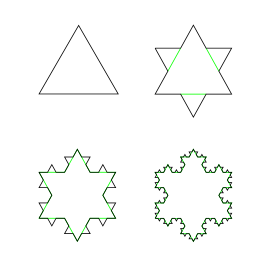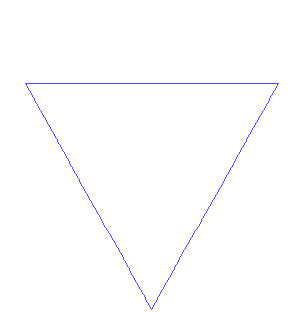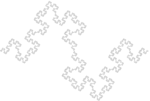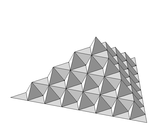Koch snowflake
From Wikipedia, the free encyclopedia

The Koch snowflake (or Koch star) is a mathematical curve and one of the earliest fractal curves to have been described. It appeared in a 1904 paper titled "On a continuous curve without tangents, constructible from elementary geometry" (original French title: "Sur une courbe continue sans tangente, obtenue par une construction géométrique élémentaire") by the Swedish mathematician Helge von Koch. (Actually Koch described what is now known as the Koch curve, which is the same as the now popular snowflake, except it starts with a line segment instead of an equilateral triangle. Three Koch curves form the snowflake.) The Koch curve is a special case of the Césaro curve where  , which is in turn a special case of the de Rham curve.
, which is in turn a special case of the de Rham curve.
One can imagine that it was created by starting with a line segment, then recursively altering each line segment as follows:
- divide the line segment into three segments of equal length.
- draw an equilateral triangle that has the middle segment from step 1 as its base and points outward.
- remove the line segment that is the base of the triangle from step 2.
The Koch snowflake/star is generated using the same recursive process but starting with an equilateral triangle rather than a line segment. After doing this once for the Koch snowflake, the result is a shape similar to the Star of David.
The Koch curve is the limit approached as the above steps are followed over and over again.
The Koch curve has an infinite length because each time the steps above are performed on each line segment of the figure there are four times as many line segments, the length of each being one-third the length of the segments in the previous stage. Hence the total length increases by one third and thus the length at step n will be (4/3)n: the fractal dimension is log 4/log 3 ≈ 1.26, greater than the dimension of a line (1) but less than Peano's space-filling curve (2).
The Koch curve is continuous everywhere but differentiable nowhere.
The area of the Koch snowflake is  , where s is the measure of one side of the original triangle, and so an infinite perimeter encloses a finite area.[1]
, where s is the measure of one side of the original triangle, and so an infinite perimeter encloses a finite area.[1]
As noted in the article on geometric series, the area of the Koch snowflake is 8/5 times the area of the base triangle.
Contents |
[edit] Representation as Lindenmayer system
The Koch Curve can be expressed by a rewrite system (Lindenmayer system).
- Alphabet : F
- Constants : +, −
- Axiom : F++F++F
- Production rules:
- F → F−F++F−F
Here, F means "draw forward", + means "turn right 60°", and − means "turn left 60°" (see turtle graphics).
[edit] Implementations
Below are a variety of implementations of the Koch snowflake.
[edit] Logo
Below is a recursive implementation in Logo. It can be tried out with most implementations of Logo, or online with the Java implementation XLogo.
Try start, call rt 30 koch 100.
to koch :x y repeat 3 [triline :x rt 120] end to triline :x y if :x < 1 [fd :x] [triline :x/3 lt 60 triline :x/3 rt 120 triline :x/3 lt 60 triline :x/3] end
[edit] Web Turtle
Here follows a sample implementation of the Koch curve for a Turtle robot written in a Logo-like language. It can be tried out online with Web Turtle. Change the value of A in the first line to any number from 1 to 5 to see the different levels of complexity.
LET A 5 ; calculate adjusted side-length LET B 243 REPEAT A LET B B/3 NEXT ; place pointer POINT 150 MOVE 140 POINT 0 ; start GO SIDE RIGHT 120 GO SIDE RIGHT 120 GO SIDE ; finished. END
; main loop # SIDE GO F LEFT 60 GO F RIGHT 120 GO F LEFT 60 GO F RETURN
; forward # F IF A > 1 ; go deeper depending on level LET A A-1 GO SIDE LET A A+1 ELSE ; or just do a single line DRAW B ENDIF RETURN
[edit] Python
Here is the Koch curve in Python.
import turtle
set="F"
for i in range(5): set=set.replace("F","FLFRFLF")
turtle.down()
for move in set:
if move is "F": turtle.forward(100.0/3**i)
if move is "L": turtle.left(60)
if move is "R": turtle.right(120)
input ()
The program can be easily modified to show the entire snowflake:
import turtle
set="F"
for i in range(5): set=set.replace("F","FLFRFLF")
set=set+"R"+set+"R"+set
turtle.down()
for move in set:
if move is "F": turtle.forward(100.0/3**i)
if move is "L": turtle.left(60)
if move is "R": turtle.right(120)
input ()
[edit] Variants of the von Koch curve
Following von Koch's concept, several variants of the von Koch curve were designed, considering right angles (quadratic), other angles (Cesaro) or circles and their extensions to higher dimensions (Sphereflake):
| Variant | Illustration | Construction | |
|---|---|---|---|
| 1D & angle=85° | The Cesaro fractal is a variant of the von Koch curve with an angle between 60° and 90° (here 85°). | ||
| 1D & 90° angle | |||
| 1D & 90° angle | |||
| 2D & triangles | |||
| 2D & 90° angle | Extension of the quadratic type 1 curve. The illustration at left shows the fractal after the second iteration. | ||
| 2D & 90° angle | Extension of the quadratic type 2 curve. The illustration at left shows the fractal after the first iteration. | ||
| 2D & spheres | Eric Haines has developed the sphereflake fractal, which is a three-dimensional version of the Koch snowflake, using spheres. (No image available) |
[edit] See also
| Wikimedia Commons has media related to: Koch curve |
| Wikimedia Commons has media related to: Koch snowflake |
- List of fractals by Hausdorff dimension
- Gabriel's Horn (infinite surface area but encloses a finite volume)
- http://www.efg2.com/Lab/FractalsAndChaos/vonKochCurve.htm












